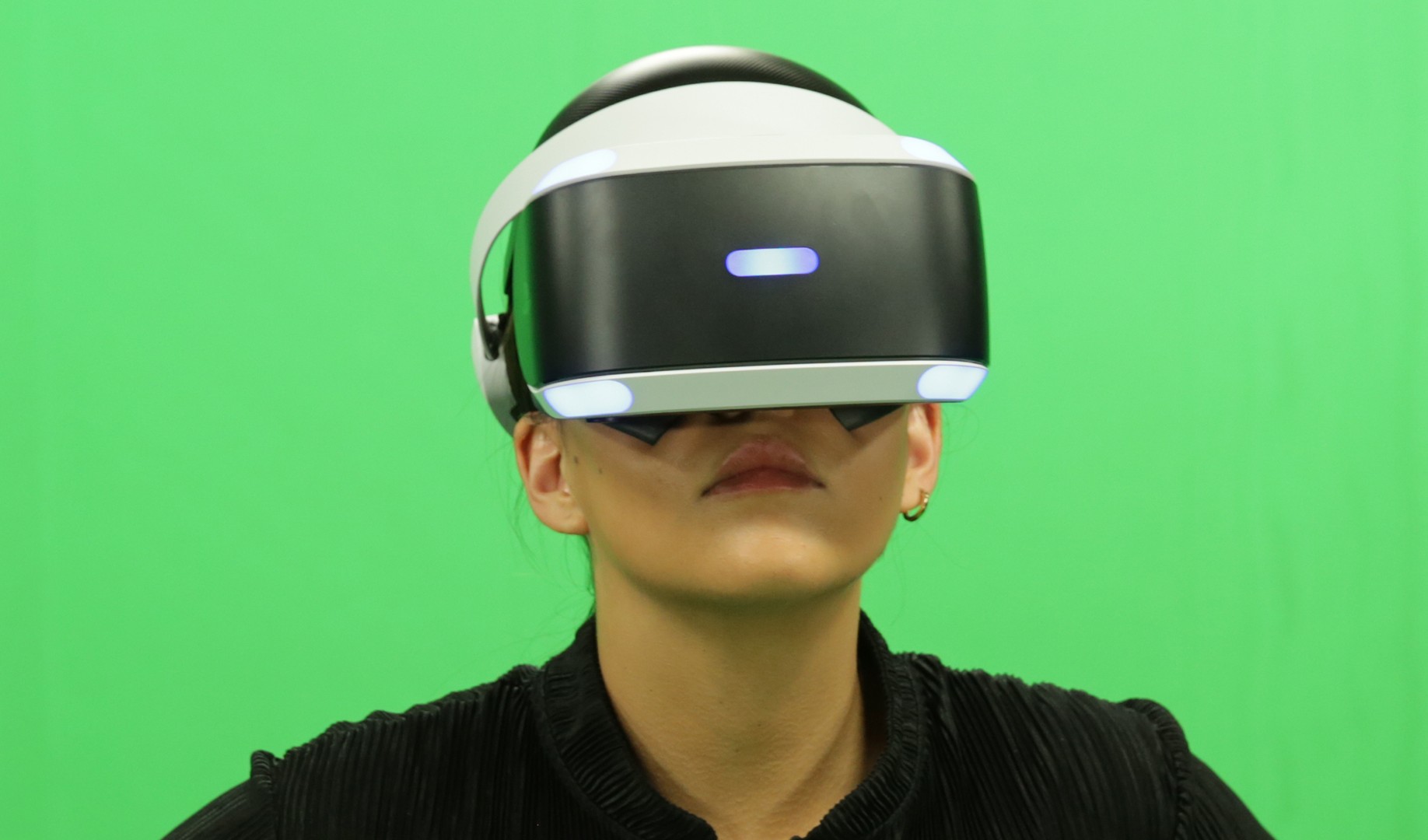Fire's licking its way up the side of my console, and smoke is streaming from a number of small blazes that have broken out all around me. A crew mate is splayed out on the deck in front, having taken an explosion to the face. On the giant screen before us, stretched across the front of the room, a sun is threatening to go supernova and wipe out any living things in the vicinity—which means the entire local system, basically. Over the communications channel, a voice threatens to blow us out of the stars in just 20 seconds, long before the flaming sphere before us collapses. A siren is screaming a warning: get the hell out of here, now. But we've still got survivors of a shattered spaceship to rescue, six more of them, and we're going nowhere until they're safely aboard. I'm on transporter detail. I lock onto each of their signals: four, five… what feels like an hour passes and then… six. "Cargo transported," flashes my engineering station screen, barely operating with sparks flying everywhere. I charge the warp coils. The aggressive voice continues to count down.
Advertisement
"Warp coils charged," I confirm with just the slightest panic. Over at the helm, a colleague has already plotted our course away from danger. "Commencing warp." The soon-to-explode sun, the wreckage now cleared of human survivors, and the Klingon battlecruiser ready to blast us into credit card-sized pieces of scrap all vanish as the USS Aegis slips into the safety of faster-than-light flight. The mission is a success: 18 out of 18 survivors rescued, ship (just about) intact. Helen, or Jennifer, or Claire, or whatever her name is who took one for the team, she'll be just fine when we run the simulation again—as we do, and perform even better, taking not the slightest damage and destroying three Klingon ships in the process. After all, this is just a game.
Star Trek: Bridge Crew, sampled on this occasion via Oculus Rift, is the best multiplayer virtual reality experience I've had so far—not that I have a great deal to go on, admittedly, both in terms of alternatives played and measuring the depth of the (full) game in question. I play this demo mission—rescue people, don't die yourself—twice in the company of Motherboard's Ben Sullivan (who's written his own assessment of the session, from the perspective of being quite the Trekkie, here) and a couple of on-hand Ubisoft representatives, which possibly gives us an advantage: after all, they've seen what plays out numerous times before. And yet, the teamwork aspect of the operation is paramount to its success, and one or two people in the four-person crew being adept won't be enough to guarantee a winning result. Communication is therefore everything in Bridge Crew—and having been a little skeptical about its novelty appeal back at E3, not being a Star Trek fan in the slightest myself, I'm surprised to find myself loving every second of each play through.
Advertisement
And that's primarily because of how this cooperative multiplayer setup works: four distinct personalities in four largely independent positions on the bridge (having fewer players will allow for crossover of responsibilities), which all need to work together in relative harmony to achieve anything. The visuals aren't anywhere close to photo real, but they do enough, combined with the constant conversation between shipmates, to impress a genuine sense of immersion. A few funny positions achieved by flailing the Oculus Touch controllers around aside, the models are adequate, serving more as basic markers for where to direct your instructions than accurate representations of actual human beings. Everyone knows their place—basically, helm steers, tactical shoots, engineering makes sure the power's diverted where it needs to be, while the captain oversees all to ensure balance across the board—and not acknowledging commands, or issuing ones of your own, will lead to disaster.Article continues after the video below
Related: Watch VICE Gaming's short film on the new frontier of virtual reality video games
Each mission—we only play the one, and it's unclear how many will be packaged when the game releases at the end of November, for all VR platforms—lasts about 15 minutes, and the relatively static environment of the bridge means that none of us come away feeling a little wobbly on our feet. I'd not—until just recently, which I'll get to in a second—felt any kind of nausea by using VR before, but Ben had, and he reported feeling fine after Bridge Crew. So that's another big tick of approval from a fan of the franchise, right there. The steady pace of proceedings—the Aegis isn't the nippiest of vessels—and lack of close-quarters environmental details rushing by your field of vision should make this a great co-op experience for anyone, regardless of whether or not they've established their VR legs. The developers at Red Storm Entertainment have clearly kept in mind the stories about motion sickness—Resident Evil VII was quite the gut-turner for many at E3 this summer—and responded with a very physically gentle experience that nevertheless manages to convey drama and excitement.
Related: Watch VICE Gaming's short film on the new frontier of virtual reality video games

Each mission—we only play the one, and it's unclear how many will be packaged when the game releases at the end of November, for all VR platforms—lasts about 15 minutes, and the relatively static environment of the bridge means that none of us come away feeling a little wobbly on our feet. I'd not—until just recently, which I'll get to in a second—felt any kind of nausea by using VR before, but Ben had, and he reported feeling fine after Bridge Crew. So that's another big tick of approval from a fan of the franchise, right there. The steady pace of proceedings—the Aegis isn't the nippiest of vessels—and lack of close-quarters environmental details rushing by your field of vision should make this a great co-op experience for anyone, regardless of whether or not they've established their VR legs. The developers at Red Storm Entertainment have clearly kept in mind the stories about motion sickness—Resident Evil VII was quite the gut-turner for many at E3 this summer—and responded with a very physically gentle experience that nevertheless manages to convey drama and excitement.
Advertisement
Being aware of sensitive stomachs is something that Guerrilla Cambridge obviously weren't bothered by in the making of RIGS: Mechanized Combat League, its PS VR-exclusive online sports-combat arena battler (or something like that: it's future-world extreme sports, with mechs). Up until I slipped on the headset for a few rounds of RIGS last night, day one of the game's public availability, I'd never truly felt sick when plugged into VR—but I managed only the tutorial, one offline match and half an online game before having to remove myself from it completely (and I took a couple of breathers before then).RIGS is fast, in your face, and so busy of visual information—there's a mini-map to study, three different modes for your mech to switch between, a health gauge and ammo counters to be aware of, plus the small matter of the opposition team members either trying to outscore you or simply tear you apart. The game does, sensibly, warn against long periods of play, and on returning to RIGS this morning—only to be matched up in competition against someone several hours deeper into practice than me, my subsequent thrashing a poor precedent-setting inevitability (I've only managed 1 vs 1 with drones so far, unable to get a 3 vs 3 game going)—I felt a lot better. But with reports of VR sickness incredibly widespread, it feels to me a risk to be putting out a game right now that absolutely necessitates a robust tolerance for being thrown around inside a gigantic robot. With a premium price tag attached, RIGS is a specialist experience that might just be beyond many players in terms of both its strain on the body and the wallet.
Advertisement
'RIGS' screenshot courtesy of Sony
Battlezone is better: Rebellion's arcade tank blaster works fine as a four-player co-op experience, although the best games are had when users actually talk to one another. Having two of the four roam away from home base to take out the enemy, while the others stay behind to defend the precious fortification, is the only way to beat the respective tile of the game's randomly generated campaign. But still, 45 minutes in the cockpit later and I wanted to eject, to come up for air. I'd been happily sliding around the slick environments of the game, for a few moments with a certain Jim Sterling in my quartet, but all of a sudden a rush came over me—that uncomfortable lurch in your belly that says, "Y'know, maybe, and it's only a suggestion, you should hang your head out of the window for a bit."The VR multiplayer games that set you in transit, all the time, are always going to face the problem of motion sickness. I don't think that VR will ever steer clear of that. Which is part of what makes Bridge Crew so exciting, to me, even as someone who really, really couldn't give a stuff about the universe its set in. It's just so accessible, so easy to slip into and, I'll go there, role-play within. That's something that a whole heap of Trekkies are going to delight in, assuming there's enough content in the final package to keep them occupied. With Touch controllers, it's very intuitive—you press buttons in the game, on a futuristic console, just as you would if they were really before you; and you turn to speak to your colleagues, just as you would on the bridge of a real-life spaceship. (A real-life spaceship in the 24th century, anyway.)I look forward to more VR games encompassing substantial social sides to their experiences, bringing us together in digital worlds like never before. RIGS and Battlezone, as two "first out the gate" contenders, probably aren't the games to offer this level of shared interactivity and communication to a wide audience: they're too twitchy, too kinetic, too competitive, for mass appeal. I like them both, and will be playing more of them, but I'm generally okay with this stuff, whereas others so evidently are not. Virtual reality, just like Video Games In General, is at its absolute best when anyone can have fun with it, as I did, as we all did, with Bridge Crew—and if these headsets ultimately prove to only be of niche appeal, the preserve of a hardcore, they have no future at all.Follow Mike Diver on Twitter.Read more gaming articles on VICE, follow VICE Gaming on Twitter, and like us on Facebook.
